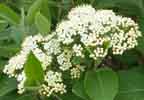|
Viburnum leaf
beetle home
Guide to identifying Viburnums
Common
names
Is
it a viburnum?
Which viburnum?
Express key
ID
tutorial
Guide to viburnums by David Swaciak.
Leaf drawings by
Marcia Eames-Sheavly.
Logo
images by Paul Weston & Craig Cramer
|
|
Leaves:
- Deciduous
- 2 to 5 inches long, 1.5 to 4 inches
wide
- Egg- to football-shaped
- Very uniform teeth
- Strongly netlike vein patterns
- Dense pubescence (hair) on
underside
- Petioles (leaf stems) .75 to 1 inch long.
|
|
Flowers:
- Flat clusters 3 to
5 inches across. White with yellow stamens.
|

Larger image. |
|
|
Fruit:
- Berries in flat clusters
- Color changes
from green to red to blue-black in August and September
|

Larger
image
|
More information:
Similar
Species and
distinguishing characteristics:
Back to beginning Which viburnum is it?
© Copyright, Department of Horticulture, Cornell University.
Project coordinator: Lori Brewer, ljb7@cornell.edu
Website design: Craig Cramer cdc25@cornell.edu
Mention of trade names and commercial products is for educational
purposes; no discrimination is intended and no endorsement by Cornell
Cooperative Extension or Cornell University is implied. Pesticide
recommendations are for informational purposes only and manufacturers'
recommendations change. Read the manufacturers' instructions carefully
before use. Cornell Cooperative Extension and Cornell University assumes
no responsibility for the use of any pesticide or chemicals. Some
of the links provided are not maintained by Cornell Cooperative Extension
and Cornell University. Cornell Cooperative Extension and Cornell
University are not responsible for information on these websites.
They are included for information purposes only and no endorsement
by Cornell Cooperative Extension or Cornell University is implied.
Cornell Cooperative Extension provides equal program and employment
opportunities.
|